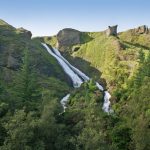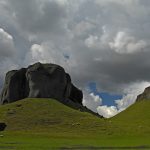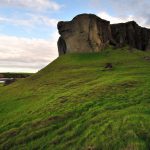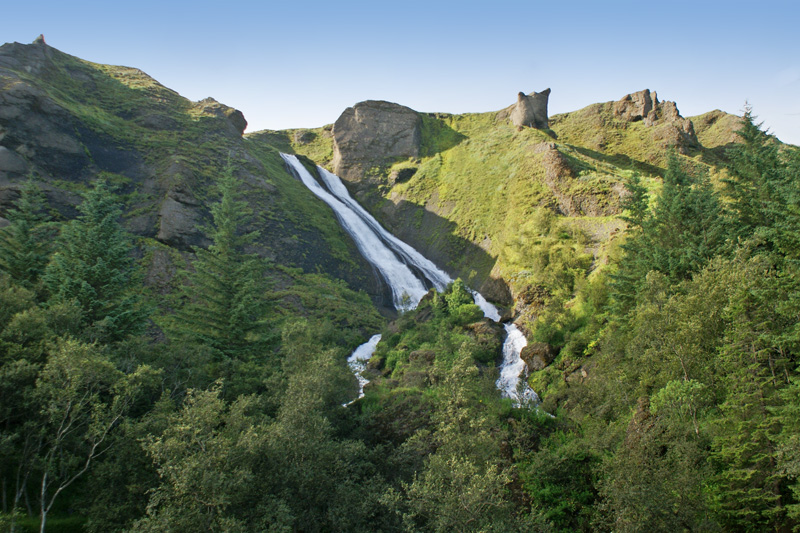Systrastapi/Systrafoss – 25 km from Dalshöfði Guesthouse
In 1186 a nun monastery was established in Kirkjubær á Síðu. It was later called Kirkjubæjarklaustur and the topographical names Systrastapi and Systrafoss are connected to this time. Systrastapi is a steep rocky hill west of Klaustur. Folklore says that on top of it, two nuns of the monastery were buried after being burned at the stake for violating codes of ethics. One is supposed to have sold herself to the Devil, carried consecrated Communion bread past the door of the privy, and had carnal knowledge with men. The other spoke blasphemously of the Pope. After the Reformation the latter nun was regarded as innocent and beautiful flowers grew on her grave, while the other one’s grave remained barren. The rocky hill can be ascended and from the top the view of glaciers, among other things, is amazing.
Systrafoss is the name of the waterfall where the river Fossá falls from the lake Systravatn, over the mountain edge above Kirkjubæjarklaustur, into the gorge Fossárgil. Low down in the gorge there’s a giant rock, Fossasteinn, that fell from the mountain during a massive thunderstorm in 1830. Beautiful hiking trails are around the waterfall and a passable hiking trail leads to the top of the mountain and Systravatn. From the mountain edge the view is breathtaking.
The folklore of the two places goes like this in Jón Árnason’s Þjóðsögur:
Above Kirkjubær there’s a beautiful mountain slope grassed over up to its edges and the edges passable in most places although it’s steep. On top of this mountain there is a vast grass-field and beautiful landscape surrounding a lake called Systravatn, for two nuns from the monastery are supposed to have gone there, either one at a time or both together. It is said that a golden comb was passed up from the lake and one of the nuns went first into the water, trying to wade to reach the comb, but the water was too deep for her and she drowned in it. The other one is said to have wanted the comb as well, but couldn’t find a way to get to it. Finally, she spotted a stone-gray horse by the lake and decided to take it and ride it into the water. But it was so big that she couldn’t mount it until it lowered its front half completely or went down on its knees. The nun then rode it into the water and none of them have ever been heard from again, the nun, the horse or the comb. This is why the lake is called Systravatn.
While Agatha Helgadóttir was an abbess at Kirkjubæjarklaustur monastery some strange things happened.
In 1336 loud groans were frequently heard in the sleeping quarters’ floor and the dining room floor at Kirkjubær, but the cause was never found.
The year Agatha passed away, 1343, Jón Sigurðsson, who had recently been consecrated as a bishop, started his visitation from Reyðarfjörður in the east, traveling west by the south coast and on his way stopped at Kirkjubær. Then, a sister whose name was Katrín was burned on the stake for ungodliness and other serious offenses she was accused, and found guilty of. Firstly that she had sold herself to the Devil in writing, secondly that she had carried consecrated Communion bread by the
door of the privy, and thirdly that she had had carnal knowledge of men, and she was therefore sentenced to be burned at the steak. Some say that two sisters were burned at this time, the other one for speaking ill of the pope, or not speaking respectably enough of him and she had therefore also been burned at the stake along with Katrín.
Skaftá runs just past Kirkjubær and a unique pillar of rock rises west of it, that’s only passable by a narrow path. On top of it, there’s a small smooth face and two mounds on the face, and people say that the mounds are the graves of the two sisters and that they were burned there and that one of the mounds is evergreen, but the other one never green, but on it grows thorn. This is why the pillar is called Systrastapi.





